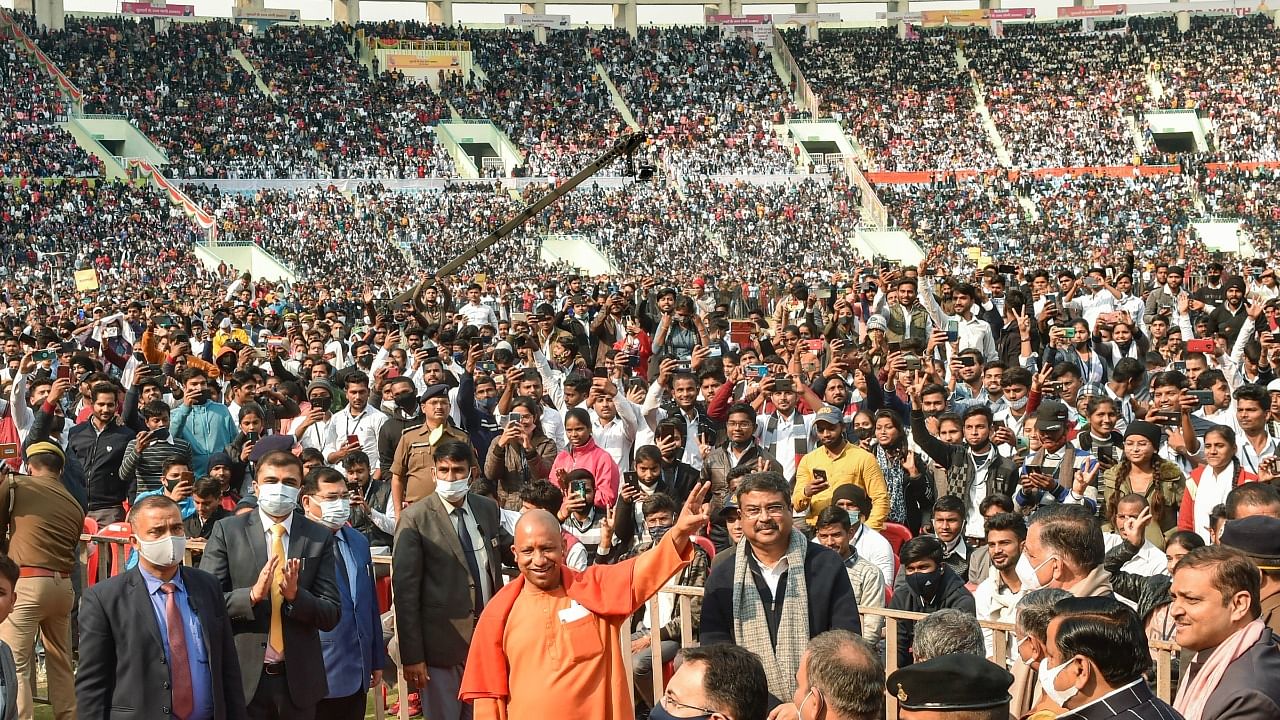
Images of bodies floating in the Ganga, video clips of an SUV mowing down farmers in Lakhimpur Kheri and cases of headline-hogging crime provided much ammunition to the opposition as Uttar Pradesh switches into the election mode.
The campaign for the Assembly elections in early 2022 has picked up much pace as the year comes to a close. There has been a flurry of visits to the state by Prime Minister Narendra Modi, launching mega projects and berating the previous governments for “neglecting” the state.
Crowded campaign rallies by the ruling BJP and the opposition parties, with hardly any Covid-19 protocol in place even amid predictions of a third coronavirus wave, has prompted the Allahabad High Court to suggest a possible ban on them.
But it was the second coronavirus wave in April-May that dented Chief Minister Yogi Adityanath’s image, with UP’s health system caught off guard, as was the case in some other states.
People struggled for hospital beds and there were long queues at cremation grounds. Even some BJP leaders questioned their own government, complaining of mismanagement.
Bodies were found floating in the Ganga in Ballia and Ghazipur districts, and buried in shallow graves on the riverbank near Prayagraj. Ballia residents claimed seeing over 40 corpses at the ghats in the Narahi area.
Authorities attributed some of this to local traditions, and the state government has been claiming that its record at fighting Covid-19 is among the best in the country.
The brutal second wave of Covid-19 roughly coincided with the multi-tier panchayat elections. Nearly nine lakh posts across the state were up for grabs. Although the elections were not fought on party symbols, both the BJP and the main opposition Samajwadi Party claimed victory.
In the backdrop, a silent tragedy also unfolded. The associations of government school teachers, called to conduct the elections, claimed that hundreds of their members died due to Covid-19 during the poll process that stretched for weeks.
The state government initially dismissed the claim, but weeks later relaxed guidelines for compensation. It announced payment of Rs 30 lakh each to the families of over 2,000 government employees, about half of them teachers, who presumingly died of Covid-19 contracted while they were on election duty.
Farmers in western Uttar Pradesh — the region from where Bhartiya Kisan Union leader Rakesh Tikait hails — boosted the ranks of protesters from Punjab and Haryana camping at Delhi’s borders.
The Lakhimpur Kheri incident, in which eight people died, created outrage and with the UP elections just months away, the opposition parties rallied around the farmers.
On October 3, an SUV ferrying BJP workers had allegedly rammed farmers near Tikunia in Lakhimpur Kheri, killing four of them and a journalist. An angry mob then lynched two BJP workers and their driver, the police claim.
The vehicles in the BJP convoy were allegedly linked to the family of Union Minister of State for Home Affairs Ajay Mishra. His son, Ashish Mishra, and 12 others have been arrested but the opposition in UP and Delhi want the minister also to be sacked.
Congress General Secretary Priyanka Gandhi Vadra was the first to head towards Lakhimpur Kheri. She was stopped in neighbouring Sitapur and spent nearly two days at a government guest house. The event served to galvanise party workers.
The Uttar Pradesh Police found itself on the defensive after a Kanpur businessman died in Gorakhpur, the CM’s native district, allegedly after being thrashed by policemen.
However, the BJP has aggressively countered the opposition claim about the worsening law and order situation in the state.
At rallies, Adityanath has accused the previous governments of encouraging mafias and terrorists. Now, bulldozers raze illegal buildings put up by dons and criminals prefer to stay away from the state, the BJP narrative goes.
And PM Modi has been praising Adityanath, particularly for bringing crime under control – contrary to the speculation months back that the BJP could replace the CM before the elections. Modi has made a series of visits to the state, which will also prove crucial in the 2024 Lok Sabha polls, inaugurating or laying the foundation stones of infrastructure projects like the 600-km Ganga Expressway, 340-km Purvanchal Expressway, medical colleges and an irrigation network in Bundelkhand.
The standout project has been the completion of the first phase of the Kashi Vishwanath Corridor. The PM took a dip in the Ganges and offered prayers at the inauguration. And his speech focused on the revival of tradition and faith, and how the country has stood up to the likes of emperor Aurangzeb.
Akhilesh Yadav’s Samajwadi Party (SP) is taking on the BJP challenge, exchanging barb for barb as the campaign progresses. Yadav has claimed that the projects for which the BJP government is taking credit were “started” when he was the chief minister.
The SP is joining hands with smaller parties, learning from its earlier not-too-happy experience of aligning with the Congress and the Bahujan Samaj Party in the 2017 assembly and 2019 Lok Sabha elections.
Lately, Akhilesh Yadav has mended fences with his uncle Shivpal Singh Yadav who had floated his own outfit, the Pragatisheel Samajwadi Party Lohia. The senior Yadav had parted ways with the nephew during the tail end of the SP government, and the trouble within the family was seen as one of the causes for the 2017 defeat.
Watch the latest DH Videos here: